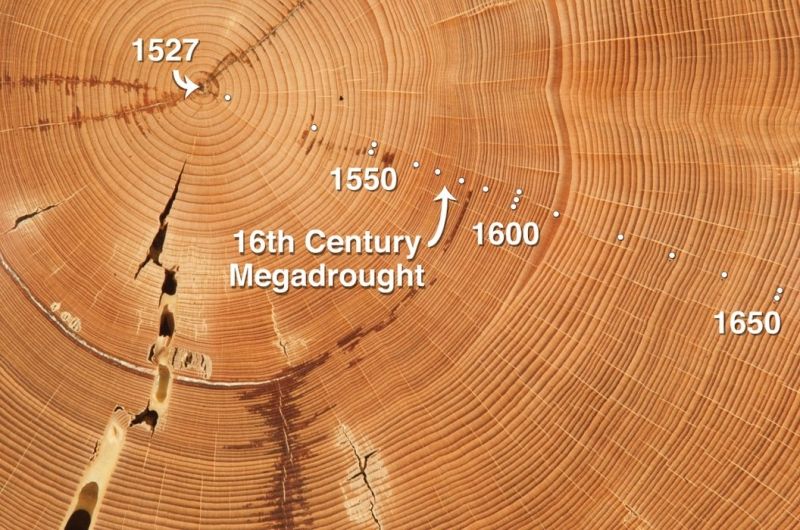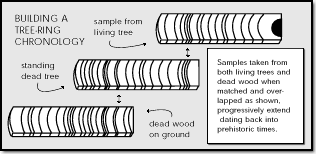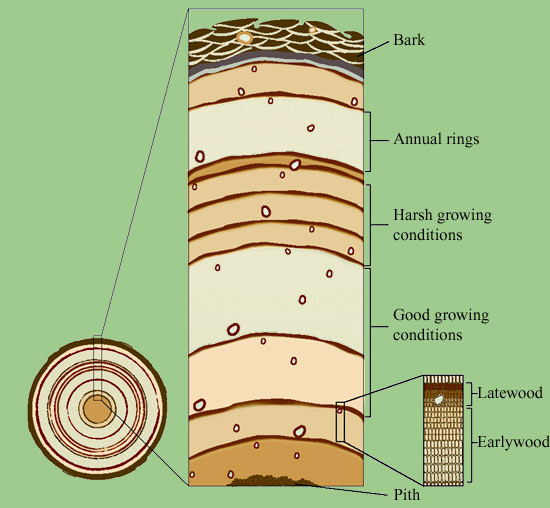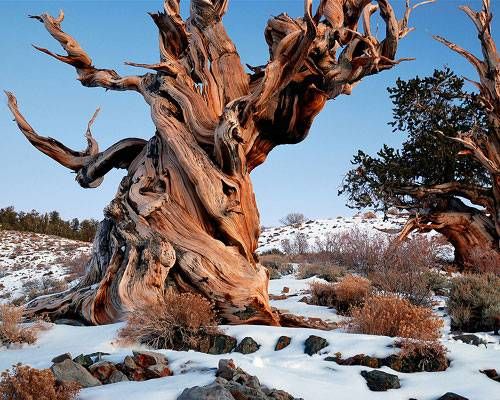Dendrochronology - Tree Ring Dating
Dendrochronology - Tree Ring Dating
based on the webpage by Leonard Miller
Simply put, dendrochronology is the dating of past events (climatic changes) through study of tree ring growth. Botanists, foresters and archaeologists began using this technique during the early part of the 20th century. Discovered by A.E. Douglass from the University of Arizona, who noted that the wide rings of certain species of trees were produced during wet years and, inversely, narrow rings during dry seasons.

Each year a tree adds a layer of wood to its trunk and branches thus creating theannual rings we see when viewing a cross section. New wood grows from the cambium layer between the old wood and the bark. In the spring, when moisture is plentiful, the tree devotes its energy to producing new growth cells. These first new cells are large, but as the summer progresses their size decreases until, in the fall, growth stops and cells die, with no new growth appearing until the next spring. The contrast between these smaller old cells and next year's larger new cells is enough to establish a ring, thus making counting possible.
Principles of Dendrochronology
A principle basic to any study of the past is the principle of "uniformity in the order of nature", first proposed by James Hutton in 1785. It is commonly stated as:The present is the key to the past.
When applying this principle to dendrochronology, it says that the variations in conditions present today must have been present in the past. This does not mean to say that the conditions are exactly the same but that similar kinds of influences affected the similar kinds of processes. Checked through a variety of methods independent of tree-ring growth, this principle has proved to be valid.
Chronology Building
The climatic changes or patterns in specific geographic areas can be traced by the study of old living trees. Samples taken from trees of unknown age can then be studied for matches with samples from trees with known sequences of growth. Using this process, when the rings "match" or are found to be overlapping in age, we are able to "see" even further back in time.n example of this occurred in the 1920's when expeditions led by Douglass dated Pueblo Bonito, a prehistoric native American settlement in New Mexico. By analysing the timbers used in its construction, they determined its existence 800 years before Columbus.
A chronology (arrangement of events in time) can be made by comparing different samples. Using a boring tool, a long slender core sample about .423 centimetres in diameter is extracted.

Lets say the sample was taken from a standing 4,000 year-old (but long dead) bristlecone. Its outer growth rings were compared with the inner rings of a living tree. If a pattern of individual ring widths in the two samples prove to be identical at some point, we can carry dating further into the past. With this method of matching overlapping patterns found in different wood samples, bristlecone chronologies have been established almost 9,000 years into the past.
Sensitivity
It is an oversimplification to say that dendrochronology is ring counting based on rainfall and the physiology of trees. Many other factors are considered. This is especially true with the old bristlecones, as their growth can be affected by slope gradient, sun, wind, soil properties, temperature and snow accumulation.

The more a tree's rate of growth has been limited by such environmental factors, the more variation in ring to ring growth will be present. This variation is referred to as sensitivity and the lack of ring variability is called complacency. Trees showing sensitive rings are those affected by conditions like slope gradient, poor soils, little moisture. Those showing complacent rings have generally constant climatic conditions such as a high water table, good soil, or protected locations.
Statistical Analysis
A number of tree samples must be examined and cross dated from any given site to avoid the possibility of all the collected data showing a missing or extra ring. Further checking is done until no inconsistency appears. Often several sample cores are taken from each tree examined. These must be compared not only with samples from other trees at the same location but also with those at other sites in the region. Additionally, the average of all data provides the best estimate of climate averages. A large portion of the effects of non climatic factors that occur in the various site data is minimized by this averaging scheme.
A number of computer programs are used to calculate statistical data. Yearly climatic changes can be seen by first removing, statistically, the gradual changes associated with the age of the tree. The end result of all the analytical work is the master chronology, an absolute form, which can be understood and used by others.

Dendrochronology can help solve many environmental problems. Tree-ring analysis can be used in a variety of ways to diagnose pollution effects in its early stages, and to help adjust certain irrigation projects. The bristlecone chronologies had raised questions regarding radiocarbon dating methods and have been use to recalibrate the C-14 process.
The bristlecone pine chronology in the White Mountains currently extends back almost 9,000 years continuously. That's to 7,000 BC! Several pieces of wood have been collected that will extend this date back even further. The hope is to push the date back to at least 8,000 BC. This will be important as the last Ice Age ended about 10,000 years ago, and to have a record of this transition period would offer scientists a wealth of information.

